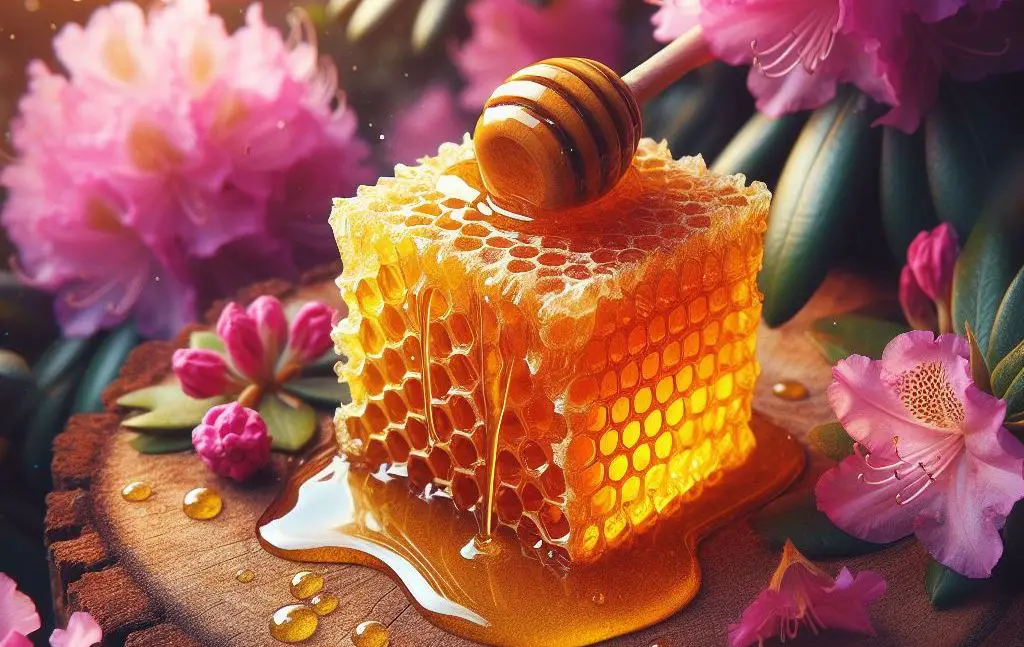In the breath-taking heights of the Himalayas, where thin air and extreme conditions challenge survival, a fascinating relationship between rhododendron flowers and giant honey bees produces one of nature’s most intriguing substances: mad honey. This unique kind of honey is called “sherpahoney” and has gained attention all overthe world for its special properties and ancient applications.
The High-Altitude Symphony
The story begins with the impressive rhododendron, a flowering shrub that had learned to survive in high-altitude landscapes. These plants grow in environments where few others could- they adapt to strong, bitter cold and high altitude along the Himalayan slopes- and survival for these plants isn’t just a testament to resilience in nature but to them being important to the ecosystems in the region. Bring in the Himalayan giant honey bee, one impressive species that has developed from these conditions. These bees have developed a unique tolerance to the cold, windy environment of the mountains. When they collect nectar from rhododendron flowers, they encounter grayanotoxins—natural compounds that give mad honey its distinctive properties.

The Making of Mad Honey
The resulting honey stands apart from conventional varieties. With its characteristic reddish-brown color and robust texture, mad honey contains small amounts of grayanotoxins that can produce mild euphoric effects. This classicalcomposition has made it a sought-after substance for centuries among mountain communities.
Traditional uses of mad honey span generations of Himalayan peoples. In controlled amounts, it has been used to promote relaxation, boost immune function, and even serve as a natural aphrodisiac. Modern research suggests potential anti-inflammatory properties, though experts emphasize the importance of responsible consumption due to its potency.
Sustainable Harvesting and Authentication
As global interest in this honey continues to grow, its harvesting should be done in an environmentally friendly way. Professional honey hunters often venture into vertical cliff faces from where this liquid gold is tapped while maintaining traditional methods but sustaining bee colonies and rhododendron populations at an ecological balance.
Good-quality mad honey is tested and certified. The most reliable producers operate directly with the governments to ensure that it is safe and authentic. For instance, Sherpa Honey works with the Nepal Ministry of Agriculture to ensure that the honey sold is authentic while at the same time affording sustainable harvesting practices.
Modern Applications and Precautions
Today, different sizes of mad honey are found in stores but at a price since it’s rare and hard to extract. Nonetheless, one should be quite careful and respectful of the honey. The experts say to start with a low dose. That’s because it might just be in minute quantities. Still, it does change the blood pressure and causes dizziness because of the grayanotoxins.
While mad honey is gaining popularity, this trend increases the challenges and opportunities. While the economic benefits to traditional communities of honey hunters are quite alluring, increased demand is exposing a fragile Himalayan ecosystem to potential threats, which are, therefore, quite crucial to managing responsibly. Responsible sourcing and consumption practices will help save this unique phenomenon from Nature for generations to come.
For those interested in experiencing this ancient delicacy, finding a reliable supplier is crucial; sherpahoney is a well-known seller offering the connoisseur of mad honey a promise of quality satisfaction coupled with same-day shipping within the U.S. Authentic mad honey that comes with proper certification and clear guidance for consumption.